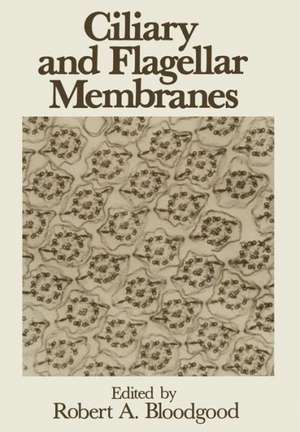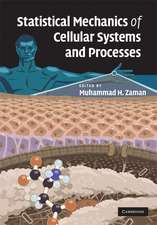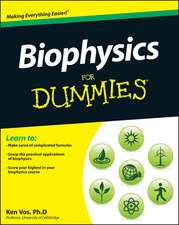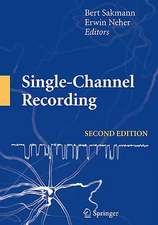Ciliary and Flagellar Membranes
Editat de R.A. Bloodgooden Limba Engleză Paperback – 4 oct 2011
Preț: 400.85 lei
Nou
Puncte Express: 601
Preț estimativ în valută:
76.70€ • 79.13$ • 64.01£
76.70€ • 79.13$ • 64.01£
Carte tipărită la comandă
Livrare economică 26 martie-09 aprilie
Preluare comenzi: 021 569.72.76
Specificații
ISBN-13: 9781461278450
ISBN-10: 1461278457
Pagini: 452
Ilustrații: 450 p.
Dimensiuni: 170 x 244 x 24 mm
Greutate: 0.72 kg
Ediția:Softcover reprint of the original 1st ed. 1990
Editura: Springer Us
Colecția Springer
Locul publicării:New York, NY, United States
ISBN-10: 1461278457
Pagini: 452
Ilustrații: 450 p.
Dimensiuni: 170 x 244 x 24 mm
Greutate: 0.72 kg
Ediția:Softcover reprint of the original 1st ed. 1990
Editura: Springer Us
Colecția Springer
Locul publicării:New York, NY, United States
Public țintă
ResearchCuprins
1. Introduction to Cilia and Flagella.- 1. Introduction.- 2. Occurrence and Function.- 3. Structure.- 3.1. The Axoneme.- 3.2. The Transition Zone.- 3.3. The Basal Body and Associated Structures.- 3.4. Accessory Structures of the Flagellar Shaft.- 4. Production of Movement.- 4.1. The Sliding Microtubule Model.- 4.2. Active Sliding Is Produced by Dynein Arms Acting on Adjacent Outer Doublet Microtubules.- 4.3. The Mechanism of Force Generation.- 4.4. Internal Resistances Convert Sliding into Bending.- 4.5. Coordination of Interdoublet Sliding.- 4.6. Central Pair Rotation.- 5. Regulation of Movement.- 5.1. Initiation of Motility.- 5.2. Behavioral Responses.- 5.3. Hyperactivation of Sperm.- 6. Sensory Reception.- 7. Origin.- References.- 2. Linkages between Microtubules and Membranes in Cilia and Flagella.- 1. Introduction.- 2. Linkage of Basal Bodies and Transition Regions to the Membrane.- 2.1. Structural Studies.- 2.2. Functions of the Bridges.- 3. Microtubule Capping Structures Attach the Ends of Microtubules to the Membrane.- 3.1. Capping Structures and Motility.- 3.2. Capping Structures and Microtubule Assembly.- 3.3. Caps Are Bound to Assembling and Disassembling Microtubules.- 3.4. Can Capping Structures Regulate Tubulin Addition to Microtubules?.- 3.5. Are Microtubule Caps Found in the Cytoplasm?.- 4. Bridges Linking the Sides of Outer Doublet Microtubules to the Membrane.- 4.1. Bridges Linking Microtubules to Extraciliary Structures.- 4.2. Sites of Attachment of the Bridges.- 4.3. Attachment to the Doublet Microtubules.- 4.4. Sites of Membrane Attachment.- 4.5. Nonciliary Microtubule-Membrane Bridges.- 4.6. Functions of the Bridges.- 5. Summary.- References.- 3. Euglena gracilis: A Model for Flagellar Surface Assembly, with Reference to Other Cells That Bear Flagellar Mastigonemes and Scales.- 1. Introduction.- 2. The Relationship of Euglenoids to Other Organisms.- 3. Flagellar Anatomy.- 3.1. Mastigonemes and the Flagellar Sheath.- 3.2. The Paraxial Rod.- 3.3. The Flagellar Membrane.- 4. Assembly of the Flagellar Surface.- 4.1. Origin of Flagellar Scales, Mastigonemes, and Membranes.- 4.2. Composition of Scales and Mastigonemes.- 4.3. Release of Mastigonemes and Flagellar Scales at the Cell Surface.- 4.4. Organizing the Flagellar Surface.- 5. The Control of Flagellar Surface Assembly in Euglena.- 6. Summary and Prospectus.- References.- 4. Gliding Motility and Flagellar Glycoprotein Dynamics in Chlamydomonas.- 1. Introduction.- 2. Gliding Motility.- 2.1. Gliding Motility-An Overview.- 2.2. Gliding Motility in Chlamydomonas.- 3. Polystyrene Microsphere Movements.- 4. Flagellar Surface Motility.- 5. Mating-Associated Dynamic Flagellar Surface Events.- 6. Characterization of the Major Flagellar Glycoproteins in C. reinhardtii.- 7. Dynamics of Flagellar Membrane Glycoproteins.- 8. Flagellar Signaling in Chlamydomonas.- 8.1. Signaling Related to Gametic Interactions.- 8.2. Signaling Related to Glycoprotein Redistribution in Vegetative Flagella.- 9. Use of Carbohydrate Probes in Conjunction with FACS to Isolate Mutant Cell Lines with Carbohydrate Defects.- 10. Use of the L-23 Mutant Cell Line to Demonstrate That Flagellar Membrane Glycoprotein Movements Are Essential for Gliding Motility.- 11. Mechanisms and Motors.- 11.1. Candidates for the Motor Responsible for Flagellar Membrane Protein Redistribution and Gliding Motility.- 11.2. A Proposed Mechanism for Gliding Motility.- 12. Conclusions.- References.- 5. The Role of Flagella in the Sexual Reproduction of Chlamydomonas Gametes.- 1. Introduction.- 2. The Agglutination Process.- 3.The Agglutinins.- 4. Mode of Action of the Agglutinins.- 5. Longitudinal Redistribution of Agglutinins.- 6. The Signaling Action of Sexual Agglutination.- 7. Modulation of Sexual Agglutinability.- 8. Conclusions.- References.- 6. The Role of Ciliary Surfaces in Mating in Paramecium.- 1. Introduction.- 2. The Events Occurring during Conjugation in Paramecium.- 3. Role of Ciliary Surfaces in the Mating Reaction.- 3.1. Mating Substances in the Ciliary Membrane.- 3.2. Localization of Mating-Reactive Cilia.- 3.3. Attempts to Isolate Pure Mating-Reactive Cilia.- 3.4. Nature of the Ciliary Interactions.- 3.5. Hydrophobic Interactions between Cilia and Polystyrene Surfaces.- 4. Regulation of the Expression of Mating Reactivity.- 4.1. Genetic Control of the Mating Type Specificity.- 4.2. Temporal Differentiation of Mating-Reactive Cilia.- 5. Results of Ciliary Interactions.- 5.1. Decrease in Swimming Velocity.- 5.2. Early Micronuclear Migration.- 5.3. Local Degeneration of Cilia and Pair Formation.- 6. Biochemical and Morphological Approaches to Characterizing the Mating Substances.- 7. General Discussion and Conclusions.- References.- 7. Calcium Ions and the Regulation of Motility in Paramecium.- 1. Introduction.- 2. Voltage-Dependent Calcium Channels.- 2.1. Voltage-Clamp Analysis of Calcium Currents.- 2.2. Calcium Channel Mutants.- 2.3. Location of Calcium Channels.- 2.4. Calcium Channel Activity in Isolated Ciliary Membranes.- 2.5. Curing of pawns and CNRs.- 2.6. Characterization of Ciliary Membrane Proteins.- 3. Enzymatic Activity Associated with the Ciliary Membrane.- 3.1. Calmodulin and Calmodulin-Binding Proteins.- 3.2. Ca-ATPases.- 3.3. Adenylate Cyclase.- 3.4. Guanylate Cyclase.- 3.5. Protein Kinases.- 4. Regulation of Cell Motility: Calcium Sensitivity.- 4.1. Ciliary Responses to Hyperpolarization.- 4.2. Ciliary Responses to Depolarization.- 5. Perspectives.- References.- 8. Structure, Turnover, and Assembly of Ciliary Membranes in Tetrahymena.- 1. Introduction.- 2. Lipid Composition.- 3. Protein Components.- 4. Ultrastructure.- 5. Turnover.- 6. Modulation.- 7. Assembly.- 8. Concluding Remarks.- References.- 9. Ciliary Membrane Tubulin.- 1. Introduction.- 2. Ciliary versus Flagellar Membranes.- 3. Protozoan Cilia and Flagella.- 4. Definitions and Origin.- 5. Metabolic Relationship between Membrane and Axonemal Tubulin.- 6. Reconstitution of Ciliary Membranes.- 7. Micellarization with Detergents and Interaction with Lipids.- 8. Tubulin as an Integral Membrane Structural Element.- 9. Summary and Discussion.- References.- 10. Lipids of Ciliary and Flagellar Membranes.- 1. Preparations of Cilia and Flagella and Their Membranes.- 2. Lipid Composition.- 2.1. Sterols.- 2.2. Fatty Acid Composition.- 2.3. Glycerolipids.- 2.4. Sphingophospholipids and Sphingophosphonolipids.- 2.5. Chlorosulfolipids.- 2.6. Lipoconjugates.- 3. Enzymes and Lipid Metabolism.- 4. Alterations in Lipid Composition.- 4.1. Culture Age.- 4.2. Dietary Supplementation.- 4.3. Drugs and Inhibitor Compounds.- 4.4. Temperature Shifts.- 4.5. Mutations.- 5. Conclusions.- References.- 11. Flagellar Surfaces of Parasitic Protozoa and Their Role in Attachment.- 1. Developmental Cycles of Kinetoplastid Protozoa.- 2. Flagellar Surfaces and Their Relation to Other Surface Domains.- 2.1. Flagellar Structure and Function in Kinetoplastids.- 2.2. Functional Aspects of the Parasite Surface: Similarity of Flagellar and Body Membranes.- 2.3. Compositional Differences between Flagellar and Body Membranes.- 2.4. Flagellar Fractions and Flagellum-Specific Antigens.- 3. Flagellar Attachment tothe Body or to Other Flagellates.- 3.1. Attachment to the Body.- 3.2. Attachment to Other Flagella.- 3.3. Attachment to Cysts.- 4. Flagellar Attachment to Host Surfaces.- 4.1. Attachment to Chitin and Other Nonliving Surfaces.- 4.2. Attachment to Living Host Cells.- 5. Role of Host Attachment in Parasite Development and Transmission.- 5.1. Specificity of Attachment.- 5.2. Parasite Reproduction and Differentiation.- Summary.- References.- 12. The Sperm Plasma Membrane: A Little More Than Mosaic, a Little Less Than Fluid.- 1. Introduction.- 1.1. Why Should the Mammalian Sperm Plasma Membrane Be Given Special Consideration?.- 1.2. Regionalization of the Sperm Plasma Membrane.- 1.3. Membrane Modification in the Absence of Macromolecular Biosynthesis.- 2. Evolving a Model for Membrane Organization and Dynamics.- 2.1. Lipid Diffusion in Biological Membranes.- 2.2. Protein Diffusion in Biological Membranes.- 3. Diffusion on Mammalian Spermatozoa.- 3.1. Constraints on Sperm Geometry.- 3.2. Lipid Diffusion on Mammalian Spermatozoa.- 3.3. Changes in Sperm Plasma Membrane Lipid Diffusibility during Spermatogenesis, Maturation, and Capacitation.- 3.4. Causes of Nondiffusing Lipid and the Question of Lipid Domains.- 3.5. Protein Diffusion on Mammalian Sperm.- 4. Mechanisms of Membrane Regionalization.- 4.1. Regionalization by Immobilization.- 4.2. Regionalization by Diffusional Barriers.- 4.3. Regionalization Due to Selective Solubility.- 5. How Does the Sperm Become Regionalized?.- 6. Mechanisms of Redistribution.- 7. Summary.- References.- 13. Structure and Assembly of the Oviduct Ciliary Membrane.- 1. Introduction.- 2. Organization of the Ciliary Membrane.- 2.1. Ultrastructural Data.- 2.2. Cytochemical Data.- 2.3. Ciliary Membrane-Cytoskeleton Relationships.- 3. Assembly of theCiliary Membrane.- 3.1. Cytoplasmic Events.- 3.2. Plasma Membrane Events.- 4. Deciliation.- 5. Functions of Ciliary Membrane in Oviduct.- References.- 14. The Surface of Mammalian Respiratory Cilia: Interactions between Cilia and Respiratory Pathogens.- 1. Introduction.- 2. The Structure and Cytochemistry of the Surface of Respiratory Cilia.- 2.1. Structure.- 2.2. Chemistry.- 3. Interactions between Pathogens and Respiratory Cilia.- 3.1. General Mechanisms of Adherence.- 3.2. Adherence of Specific Pathogens to Respiratory Cilia.- 4. Toxicity of Microbial Products for Cilia.- 5. Summary: Implications of Ciliary Surface Composition to the Therapy of Infections of Cilia.- References.- 15. The Photoreceptor Connecting Cilium: A Model for the Transition Zone.- 1. Introduction.- 2. Structure of Photoreceptor Cilia.- 3. Microtubule-Membrane Cross-Linkers of the Connecting Cilium.- 3.1. The Ciliary Surface and Its Transmembrane Assemblage.- 3.2. Identification of Surface Components of the Assemblage.- 3.3. The Periciliary Ridge Complex.- 4. Functions of the Photoreceptor Connecting Cilium.- 4.1. Delivery of Membrane Components.- 4.2. The Connecting Cilium in Disk Morphogenesis.- 4.3. The Connecting Cilium as a Barrier between Membrane Domains.- 4.4. Delivery of Cytosolic Components to the Outer Segment.- 5. Summary.- References.











